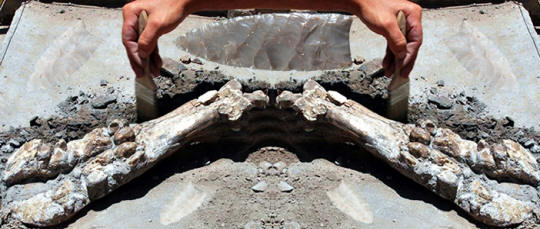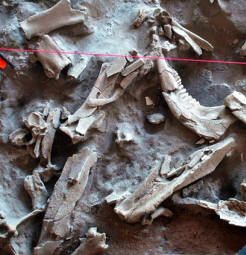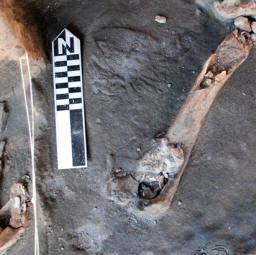|
"One of the most
important areas investigated by students of Early Man is (Blackwater
Draw) a section between Clovis and
Portales in New Mexico which contains the remains of ancient lake beds."--------1957,
H. M. Wormington, "Ancient Man In North America" p. 47.
"Late in 1936
the finds (at Blackwater Draw,
Locality #1) began to receive
national publicity. Popular articles describing the association of human
artifacts with extinct animals appeared in the "New Mexico Magazine" and
the "Literary Digest."------1972,
James J. Hester, "Blackwater Locality No. 1",
p. 4.
"The
distinctive weapon tips found with mammoth bones at Blackwater Draw were
named after the nearby town, and the people who produced these points
have since been known as Clovis."--------2012,
Dennis J. Stanford and Bruce A. Bradley, "Across Atlantic Ice, The
Origin Of America's Clovis Culture," p. 5.
"Blackwater
Draw, Locality 1, New Mexico is a kill and camp (site).
It was the first site to show that Clovis artifacts and mammoth remains
were stratigraphically beneath, and thus older than, Folsom."----2006,
Bruce B Huckell and W. James Judge, "Paleo-Indian: Plains and
Southwest,"
Handbook Of North American Indians, Environment, Origins, And
Population, Vol. 3, p. 152.
"Blackwater Draw, Locality 1, contains a series
of Folsom locales, including at least six bison bone beds (kill
sites), three camps, and an unusual
suite of Folsom points and other artifacts from a spring conduit."---------2006,
Bruce B Huckell and W. James Judge, "Paleo-Indian: Plains and
Southwest,"
Handbook Of North American Indians, Environment, Origins, And
Population, Vol. 3, p. 154.
"Blackwater Draw
produced the first Clovis blade assemblage to be recognized and
described as such (Green 1963),
and for over thirty years the data on those blades as detailed by Green
have been the nearest thing to a type description or definition."---------1999,
Michael B. Collins, "Clovis Blade Technology, A Comparative Study
of the Keven Davis Cache, Texas," p. 150.
"In the Black
Water Draw between the towns of Clovis and Portales, 180 miles south of
the Folsom site in eastern New Mexico, the assemblage of bones and
cultural material is found in a bluish-gray deposit that is believed to
be the bottom of old lake beds that correlate with the high-water stage
of ancient Lake Estancia located some distance farther west."---------1944,
Frank H. H. Roberts, "The New World Paleo-Indian," Annual Report
of the Board of Regents of the Smithsonian Institution, p. 405.
"In the decades
after the publication of the original Clovis discoveries, Clovis
artifacts were documented throughout most of North America and as far
south as Venezuela."--------2012,
Dennis J. Stanford and Bruce A. Bradley, "Across Atlantic Ice, The
Origin Of America's Clovis Culture," p. 5.

BLACKWATER DRAW
CLOVIS TYPE SITE
ROOSEVELT COUNTY, NEW MEXICO
est. 13,500 years
ago
In 1927 most archaeologists were not convinced
that people were living in North America at the end of the late
Pleistocene period. But the discovery of the Blackwater Draw site, in the early 1930's,
literally changed history. Blackwater Draw provided
scientists with unquestionable proof of a previously unknown ancient
people. This site actually moved the human timeline back farther than
all the other archaeological sites that had been discovered previously.
Blackwater Draw provided one of the most fascinating chapters in the
archaeological record, known as the Clovis cultural tradition.
Blackwater Draw is recognized as the Clovis type site. |
|

PHOTO CREDIT GEORGE CRAWFORD
CLICK ON PICTURE FOR LARGER IMAGE
INTERPRETIVE CENTER
BLACKWATER DRAW SITE
NEW MEXICO
This picture shows the Interpretive
Center and the small structure that covers a Clovis well. The
Interpretive Center is the largest building on the Blackwater Draw site and
open to the public. The steel structure covers a 3,500 foot area.
The building was built in 1997 over exposed bones that were
weathering out of the excavated hillside. Excavation inside the
building is on-going and should eventually display all the different
archaeological horizons that are represented on the site.
One of the most unique archaeological features at Blackwater Draw are the
ancient wells. Approximately twenty wells have been discovered. Most
of them date to the Archaic period. But at least one or more date to
the Clovis period and are
estimated to be at least 13,000 years old. These wells were dug down to
the water bearing gravels with either tortoise shell, stone, bone or
wooden tools. A small building, that can be seen in this picture, covers one of the oldest wells on the
site and it's recognized as the oldest well and water control system in North America.
The Blackwater Draw site is open
to the public. Admission to the site is free on the fourth Sunday of
each month. Normal admission cost is $1, $2 & $3. according to age
and under 5 years are free. The schedule in the summer is, Monday -
Saturday: 10 a.m. to 5 p.m. and on Sunday: noon to 5 p.m. For the
remainder of the year Tuesday - Saturday: 10 a.m. to 5 p.m. and on
Sunday: noon to 5 p.m. The museum may be closed on major holidays.
The site is located about 8 miles north of Portales, New Mexico on
highway 467. Call for more information, 575-562-2202. |
|
|
The name Blackwater Draw comes from an ancient river bed that extends
from New Mexico into western Texas for well over 85 miles. Sometime in
the geologic past the headwaters of this river was captured by the Pecos
River and most of its running water was drained away. The area is
located on the western edge of a large plateau known as the Llano
Estacado and is situated approximately 4,000 feet above sea level. Some
locations in this area have a long history of
providing some of the most important archaeological finds in North
America. |
|
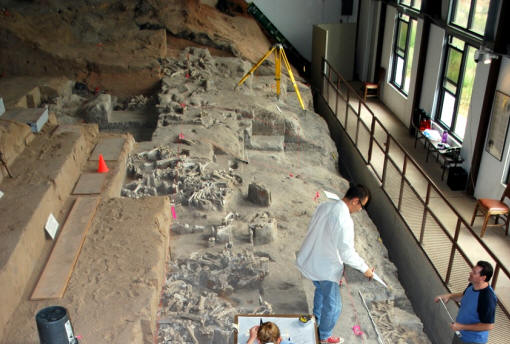
PHOTO CREDIT GEORGE CRAWFORD
CLICK ON PICTURE FOR LARGER IMAGE
INSIDE INTERPRETIVE CENTER
BLACKWATER DRAW SITE
NEW MEXICO
This picture shows an
interior view of the Interpretive Center on the Blackwater Draw site.
The building serves to preserve the fragile bones from erosion and offers a unique
display of one of North America's most important archaeological sites.
The excavation has exposed several different levels of occupation that
span many thousands of years.
The animals were killed primarily for food and secondarily for hides, bone and ivory. The excavation
is still in progress and the area of displayed bones will expand over
time. |
|
|
The archaeological significance of Blackwater Draw is
centered around an area known as Blackwater Draw Locality #1. The site
dates to the Late Pleistocene period when the last Ice Age was
beginning to recede. The area was once part of a lake or marsh that was
spring fed. This water source was the most important natural resource
for the animals and for the people who were hunting them. The
archaeological site is actually a combination of at least 13 sites. Some
of the excavations are located at the margin of the ancient lake shore
and others were dug just outside the margin of the ancient lake shore.
These excavations have identified kill sites and camp sites. |
|
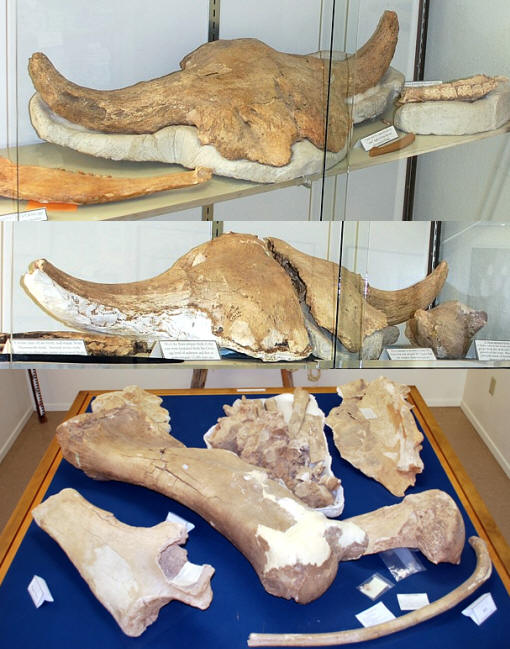
PHOTO CREDIT GEORGE CRAWFORD
DISPLAYED BONES IN VISITOR CENTER
BLACKWATER DRAW SITE
NEW MEXICO
This picture shows some of
the extinct animal bones on display in the visitor center on the
Blackwater Draw site. The two pictures at top show the upper portion of
two different bison antiquus skulls complete with horn cores. The lower
picture has one large mammoth leg bone in the center of a group of other
bones from the site. |
|
|
The Blackwater Draw site has a long history of occupation.
The site dates to sometime around 13,500 (calibrated) years ago to
recent Historic times. The early period occupation levels are clearly
marked between stratified layers of lean years, when the lake was
dry, and wet years. Layers of culturally sterile soil was deposited
during times of drought. The site is noted for its complete sequence of
occupation levels from Clovis (13,500 years ago) through the Archaic
period (6,000 years ago). |
|
|
|
Archaeological sites seem to accumulate different names
over the years and the Blackwater Draw site is no exception. The site
has been referred to as Blackwater Draw, Blackwater Draw locality #1,
the Clovis site and the Anderson Basin site. Most authors use either
Blackwater Draw or Blackwater Draw locality #1 to refer to the
archaeological site area. |
|
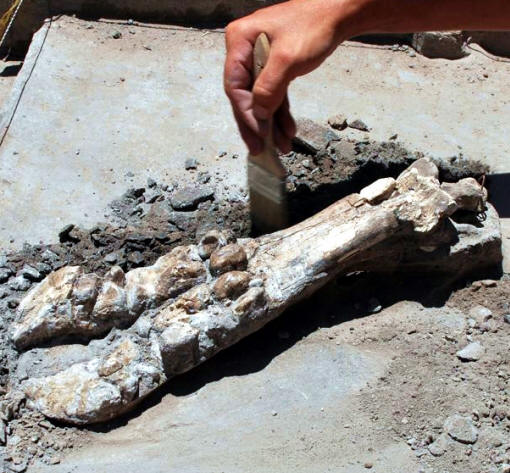
PHOTO CREDIT GEORGE CRAWFORD
EXCAVATING BISON LEG BONE
BLACKWATER DRAW SITE
ROOSEVELT COUNTY, NEW MEXICO
This picture shows a bison
leg bone as it's being uncovered in a kill site area at Blackwater Draw.
This is a recent excavation that was done sometime between 2009 & 2011.
The level of excavation is in stratum E and the Archaic period
occupation. This bison may not be an extinct variety but a modern animal
of a type still living today. |
|
|
Ridgely Whiteman, of Clovis, New Mexico, was the first person
to recognize the importance of the Blackwater Draw site and is
considered the discoverer of the site. His hobby was looking in dry
gullies and stream beds for any fossils and artifacts he could find. On
one of his trips in 1929 he found a large mammoth bone and a point type
that was new to science. This point would later be recognized as a
Clovis point. He sent both pieces to the Smithsonian Institution hoping to
generate some interest among the scientists. |
|
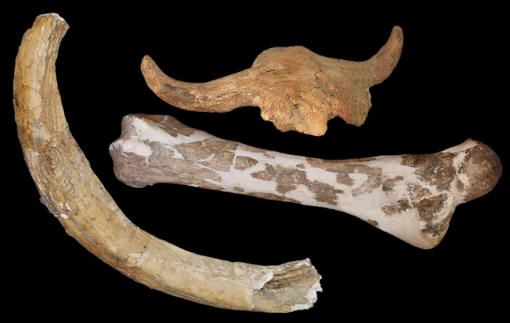
PHOTO CREDIT GEORGE CRAWFORD & COMPUTER
ALTERED BY PETE BOSTROM
BISON ANTIQUUS SKULL, MAMMOTH
BONE
& AN IVORY MAMMOTH TUSK
BLACKWATER DRAW SITE
ROOSEVELT COUNTY, NEW MEXICO
These three
large fossil specimens are on display in the visitors center on the
Blackwater Draw site. They all represent animals that were present
during the Clovis occupation on the Blackwater Draw site. The upper
portion of a bison antiquus skull with horn cores is an excellent
example. The large bone in the center is a leg (femur) bone from a
mammoth and the lower specimen is a fairly complete tusk from a mammoth. |
|
|
Serious archaeological investigation of the Blackwater Draw
site began in 1932 after gravel mining operations revealed a rich
concentration of extinct animal bones and artifacts. Unfortunately, the
fossil rich Clovis related strata was located just above the
commercially desirable gravel. The open pit mine
supplied gravel for area road construction as it was sporadically needed from 1932
to 1978. The mine was initially opened to produce gravel for a
connecting road between Clovis and Portales. Hester reports that by the
mid 1950's, as much as, 400 cubic yards of gravel and overburden were
being removed every day. |
|
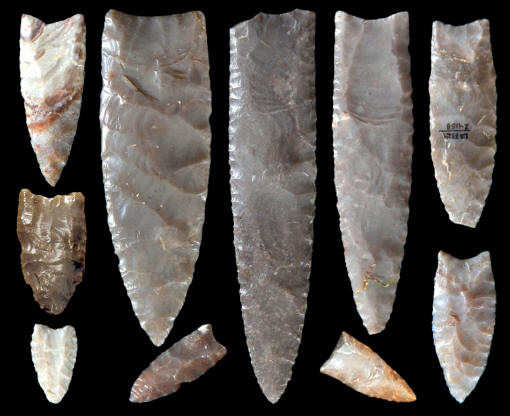
PHOTO CREDIT GEORGE CRAWFORD & COMPUTER
ALTERED BY PETE BOSTROM
CLICK ON PICTURE FOR LARGER IMAGE
CLOVIS POINTS
BLACKWATER DRAW SITE
ROOSEVELT COUNTY, NEW MEXICO
These Clovis points were found on the Blackwater Draw site. They're
all complete or nearly complete projectile points. The large point
in the center has damage to both ears and the point at top right has
tip damage caused from impact. The three largest points were found
during the excavation of a mammoth by George Agogino at the north
end of the site in about 1964. The widest point on the left was
found in the mammoth's body cavity. A total of 9 Clovis points were
found in the mammoth. Clovis points from Blackwater Draw exhibit a
wide range of sizes. The longest point in this picture measures
approximately 5 1/8 inches (13 cm) long and would measure longer
with restored ears. The smallest Clovis point in this picture
measures about 1 inch (2.5 cm) long. The three longest points are
made of Edwards chert. |
|
|
The gravel mining operation on the Blackwater Draw site
revealed a distinctive geological layer that's been referred to in
different ways: as the bluish-gray deposit, the blue layer, blue sands
and, gray sand. They all represent the same ancient
lake bed that once supported a lush environment for a wide range of now
extinct animals and for the Clovis people who once hunted them.
Lundelius wrote in 1972 that the gray sand at the Blackwater Draw site
"---is the oldest Late-Pleistocene unit with abundant vertebrate
fossils." |
|
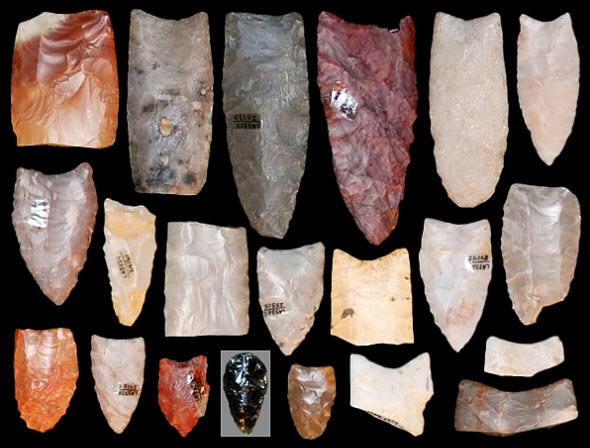
PHOTO CREDIT GEORGE CRAWFORD & COMPUTER
ALTERED BY PETE BOSTROM
CLOVIS POINTS
BLACKWATER DRAW SITE
ROOSEVELT COUNTY, NEW MEXICO
These Clovis points were
found on the Blackwater Draw site. Most of them are broken from impact
damage rather than broken during the manufacturing process. The majority
of them were found in the kill site areas and associated with extinct
animal bones such as mammoth and bison antiquus. The are made from
several different types of stone. The more common types are Edwards and
Alabates chert. One of the least common would be Obsidian, like the
example at bottom center. |
|
|
Archaeological investigations in the 1930's provided the
first and basic scientific description of the Blackwater Draw site. Stewart
Northrup, Clyde Kluckhohn and Paul Reiter of the University of New
Mexico, the School of American Research, and the State Museum were some
of the earliest researchers on the site. But the one who organized and
provided the best research during those years before WWII was Edgar B.
Howard of the University of Pennsylvania, Museum of Archaeology and
Anthropology. In fact he is credited with being one of the first
archaeologists to employ an interdisciplinary approach with a team of
scientists from different fields. The research done in the 1930's was
able to identify the site as an extensive Clovis kill site that predated
the Folsom culture. |
|
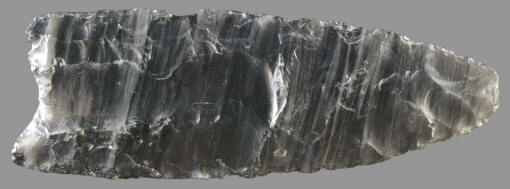
COLLECTION OF THE DENVER MUSEUM OF NATURAL HISTORY
CLICK ON PICTURE FOR LARGER IMAGE
CLOVIS POINT
BLACKWATER DRAW SITE
ROOSEVELT COUNTY, NEW MEXICO
This Clovis point was originally part of the collection of George C.
Roberts of Clovis, New Mexico. It was donated to the Denver Museum
of Natural History in the 1940's. It's believed to have been found
on the Blackwater Draw site. Roberts was collecting at the site
during the early gravel mining operations. According to
archaeologist George Agogino, Roberts collected at Clovis and
nowhere else. Obsidian sourcing was done on the point in 1988 and
was found to be from the Wild Horse Canyon Mineral area in
southwestern Utah. The tip of the point seem to have been damaged
from impact. The longest flute measures 2 inches (5.1 cm) long This
point is made of Obsidian and it measures 4 inches (10.2 cm) long. |
|
|
Excavation at the gravel pit was sporadic over the years.
Some of the most dramatic discoveries were reported in the early 60's
between 1962 and 1964. Salvage excavations were non-stop, by many
different groups. The mining company owned the lease to the property and
controlled who could dig there. Hester reports that,"---no one
institution remained in favor with the gravel pit operator for any
length of time." Some of the most interesting finds during this period
were the discovery and excavation of five mammoths that were found in association
with over 100 artifacts. |
|
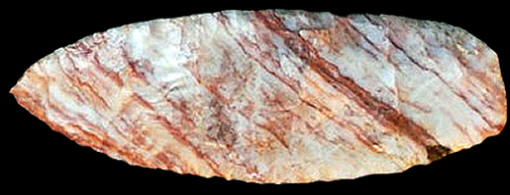
PHOTO CREDIT GEORGE CRAWFORD & COMPUTER
ALTERED BY PETE BOSTROM
CLOVIS KNIFE OR POINT
BLACKWATER DRAW SITE
ROOSEVELT COUNTY, NEW MEXICO
This point or knife was
found in the Clovis occupation stratum on the Blackwater Draw site. It's
made of Alabates chert and it measures 4 3/4 inches (12 cm) long. |
|
|
The most important artifacts
that were recovered from the Blackwater Draw locality #1 site are the
oldest tools that make up the
previously unknown Clovis tool kit. In 1972 Hester described 223 Clovis
artifacts from Blackwater Draw. At that time they were the largest collection
of Clovis artifacts from any kill site or camp
site. Ninety-five of the artifacts were flakes, of which 53.5% had been
used for either cutting or scraping. Seventeen of the tools were
represented by side-scrapers. The third largest number of artifacts were
Clovis projectile points. He described the rest of the stone tools as
end-scrapers 4, gravers 5, unifacial knives 11, bifacial knives 11,
flake scrapers 12, flake knives 7, hollow edge scrapers 4,
scraper-gravers 1, indeterminate scrapers 2, end and side-scrapers 6,
choppers 1, cores 1, hammerstones 5, pebbles 5, channel flakes 1, burin
and scraper 1, flake scraper knives 1, flake knife-gravers 2, chips 4,
pebble scrapers 1, grinding stones 1, and bone artifacts 14. 45.7% of
the tools were made from Edwards chert. It was determined that the
Clovis stone tool industry was producing their flakes by striking them
from prepared
cores to manufacture stone implements. |
|
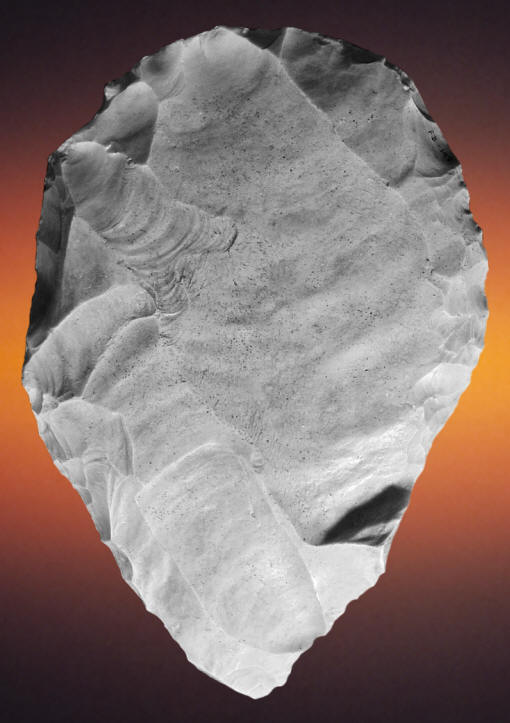
PHOTO CREDIT GEORGE CRAWFORD & COMPUTER
ALTERED BY PETE BOSTROM
LARGE CLOVIS BIFACE
BLACKWATER DRAW SITE
ROOSEVELT COUNTY, NEW MEXICO
This is the largest Clovis
biface that's been found on the Blackwater Draw site. It was found by
Frank Broilo on the surface at the northwestern corner of the site. The
large percussion flake removal scars are a signature of Clovis stone
tool manufacturing. The reduction flakes would have been further
utilized to make several different types of tool forms for cutting,
scraping and piercing processes. This biface is made of Edwards chert
and it measures approximately 9 9/16 inches (24.3 cm) long and 6 5/8
inches (16.8 cm) wide |
|
|
Blackwater Draw has produced more Paleo-Indian bone tools
than any other site. In 1972 Hester described a Clovis bone artifact assemblage
that represented 6.2% of the total Clovis material. Some of the artifact
types he described are bone fleshers, bone awl, bone points, bone
scraper or knife, and a bone bead. Most of the artifacts a were listed as a
bone tool because they show some type of modification, such as grinding
but cannot be identified as a tool type. One or more of the bone points
are similar to the bone rods found on the East Wenatchee site in
Washington. |
|
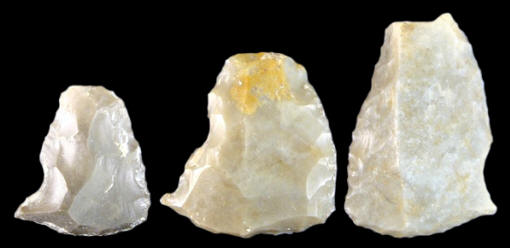
PHOTO CREDIT GEORGE CRAWFORD & COMPUTER
ALTERED BY PETE BOSTROM
SPURRED END-SCRAPERS
BLACKWATER DRAW SITE
ROOSEVELT COUNTY, NEW MEXICO
These three
"spurred" end-scrapers were found within the Clovis occupation stratum
on the Blackwater Draw site. Scrapers are one of the most common tool
forms that have been found on Stone Age sites around the world. End scraper is the most commonly used term to describe these simple
tools. They have also
been referred to as transverse and distal edge tools or even as grattoir
terminal in European terminology. End scrapers might also be described
as a multipurpose tool as these examples clearly have scraping edges at
their widest ends and spurs at their corners that could be used as
gravers. Next to common
un-modified flakes, unifacial tools represent the largest group of tool
forms that were made by Stone Age cultures during the Upper Paleolithic
period. Most end scrapers are either triangular or tear drop in shape.
The working edge is usually the thickest area
of the tool and located opposite the bulb-of-percussion. End scrapers
are unifacial tools that
were made from blades and flakes by removing small flakes around the
edges from one side with pressure. It's generally believed that end scrapers were hafted onto
short handles. In fact, a good percentage of stone artifact tool forms
were once hafted onto handles or spear and arrow shafts. On the Hell Gap
Cody Complex site in Wyoming, evidence of hafting abrasive wear was
observed on some of the end scrapers. A handle offers the tool user better leverage to press against
the material being scraped. End scrapers are mainly a product of core
and blade technology. So it's not surprising that they first appear
during the Late Paleolithic period with the introduction of blade
technology. End scrapers were used to process and shape softer organic
materials such as animal hides, antler, bone, and wood. But their most
common use may have been for scraping animal hides. Eskimo cultures were
using hafted end scrapers to process skins for clothing, boats, tents,
dog harnesses, etc. Primitive cultures around the world have used end
scrapers to process all types and sizes of animal hides. |
|
|
More Folsom artifacts
were described by Hester in 1972 than Clovis. They were recovered from
kill sites within the ancient lake margin and from campsites that were
located just outside the ancient lake margin. In 1972 he lists 534
Folsom artifacts. The most common are 234 flakes, most of which were
struck from prepared cores. 61.7% were
used for either cutting or scraping. The second most common Folsom
artifact type he described are Folsom projectile points which are represented by 79
examples and 14.8% of the collection. He identifies 23 different tool
types, of which 9 occur in frequencies greater than 1%. The 1% plus
tools are identified as flakes, points, side-scrapers, end-scrapers,
unifacial knives, bifacial knives, flake scrapers, flake knives, and
channel flakes. The Folsom bone tools represent only .7% of the
1972 collection. They include 4 bone tool fragments and one piece of a
bone disk ornament that was decorated with straight lines. |
|

BONE RODS
EAST WENATCHEE & BLACKWATER DRAW SITES
WASHINGTON & NEW MEXICO
Both of these bone tools
date to the Clovis cultural complex. The example at top is referred to
as a bi-beveled bone rod. It was found in a cache along with 12 other
examples, during the excavation of the East Wenatchee Clovis site in
Washington. It seems to compare in size to the broken example pictured
just below that was found on the Blackwater Draw site. They were
probably made from the long bones of mammoths.
Although their purpose has yet to be proven, several theories have been
suggested. Everything from sled runners, foreshafts and flintknapping
tools have been discussed as possible uses. The example at top measures
9 7/8 inches (25.1 cm) long. |
|
|
The stone tool
industries that appear above the Folsom horizon at Blackwater Draw
include late Paleo-Indian types, Cody Complex and Archaic type
projectile points and tools. A few examples include Plainview, Agate
Basin, Eden and Scottsbluff. Agate Basin appears directly above Folsom
on the Agate Basin site, the Hell Gap site and at Blackwater Draw. The
Agate Basin complex dates to between 10,500 and 10,250 years ago. |
|
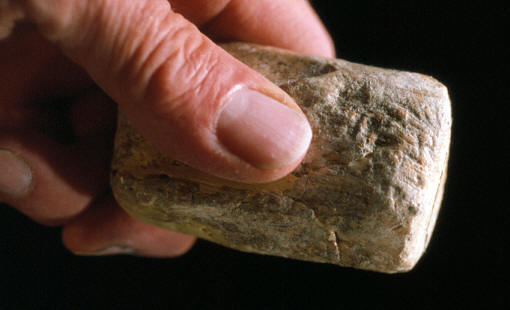
MAMMOTH IVORY BILLET-BURNISHER
BLACKWATER DRAW SITE
ROOSEVELT COUNTY, NEW MEXICO
This Clovis period ivory artifact was discovered in 1962 by J. D.
Murray. He was an employee of the Sam Sanders' Gravel Pit located in
Roosevelt County, New Mexico. It's been described as a
multi-functional tool that was used as both a flintknapping tool and
a hide processing tool. This short and cylindrical artifact was cut
from a section of mammoth ivory. Both ends are slightly
convex and it's been compared in shape to the head of a two pound
hammer. This ivory tool measures 3 inches (7.35 cm) long, 1 13/16 inches (4.6
cm) wide and 1 5/16 inches (3.48 cm) thick (the ivory may have
shrunk slightly since these measurements were first made).
Both of the ends of the
Blackwater Draw
Billet-Burnisher are slightly convex.
Agogino and Haynes concluded at the time of its discovery that the
smoothness of one end indicated that it was used as a polisher
possibly for leather. The other end was not nearly as smooth.
Flintknapper Mike Dothager has experimented with a replica of this
ivory tool. His copy is similar in size
and shape but differs in material which is moose antler. He has
demonstrated that a tool of this design can be used to duplicate
Clovis style flake removals, when it's used as a hammer to strike a
punch. |
|
|
Many different types of vertebrate animals have been
identified from bones found in the gray sand in the gravel pit. These
animals were alive during the end of the most recent Ice Age, known as
the late Pleistocene. Some of these animals include, turtles, dire wolf,
gray wolf, coyote, fox, sabertooth cat, muskrat, peccary, 2 different
types of camel, antelope, bison, 3 species of horses, and mammoth. |
|

PHOTO CREDIT GEORGE CRAWFORD & COMPUTER
ALTERED BY PETE BOSTROM
FOLSOM POINTS
BLACKWATER DRAW SITE
ROOSEVELT COUNTY, NEW MEXICO
All of these Folsom points
were found on the Blackwater Draw site. They were found during the
excavation of the northcentral bank at the edge of the ancient lake.
They were laying in and around the bones of extinct animals. Most of
them are damaged from impact. The complete examples show extensive
resharpening. Very good unresharpened Folsom points are very rare. |
|
|
J. D. Murry was a local man who worked at the Blackwater Draw
gravel pit and operated the mining dredge. He was able to acquire one of the largest private
collections of fossil bones and artifacts from the site, probably
because he was there most of the time. It's estimated that he collected
"buckets of artifacts." One story goes, that his boss had a hard time
keeping him on the equipment and not jumping off every time something
turned up. Hester writes that in 1963 Murry, "located a hot spot of
artifacts near the area that had just been excavated and recovered about
50 artifacts in two hours of digging." After this discovery, a group of
students from Eastern New Mexico University came out and recovered
another 200 artifacts in two days. |
|
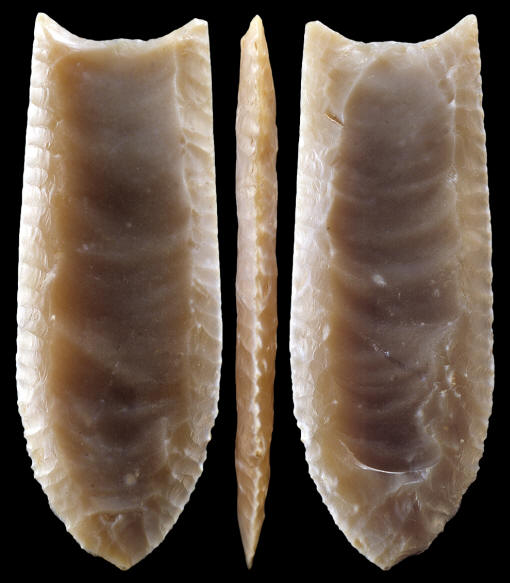
CLICK ON PICTURE FOR LARGER IMAGES
FOLSOM POINT
BLACKWATER DRAW SITE
ROOSEVELT COUNTY, NEW MEXICO
This
Folsom point was found sometime in the 1930's at the Clovis Gravel Pit
in Roosevelt County, New Mexico before it was named the Blackwater Draw
site by archaeologists. It was originally in the Charles Rhoton
collection. This point is made of a semi-translucent tan chert of good quality and
measures 2 1/8 inches (5.3cm) long. |
|
|
Some of the most unique archaeological features at Blackwater Draw are the ancient wells. Approximately
twenty wells have been discovered. Most of them date to the Archaic
period. But at least one or more date to the Clovis period and are
estimated to be at least 13,000 years old. These wells were dug down to
the water bearing gravels with either tortoise shell, stone, bone or
wooden tools. A small building covers one of the oldest wells on the
site and it's recognized as the oldest well and water control system in North America. |
|
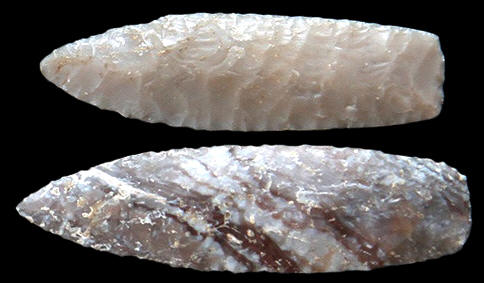
AGATE BASIN POINTS
BLACKWATER DRAW SITE
ROOSEVELT COUNTY, NEW MEXICO
Both of these Agate Basin points were
found on the Blackwater Draw site. The point at top may have been picked
up in the gravel mining operation. It shows extensive resharpening on
the point. The lower point is made of Alabates chert. It was found in
stratum D within the jaw of a bison antiquus. The animal was evidently
shot in the mouth with this point.
Agate Basin appears directly above Folsom on the
Agate Basin site, the Hell Gap site and at Blackwater Draw. The Agate
Basin complex dates to between 10,500 and 10,250 years ago. |
|
|
The Blackwater Draw locality #1 site currently represents
thirteen different localities or different excavation areas that are
situated on the edge of an ancient lake bed. Eastern New Mexico
University purchased 157 acres of the site in 1978. The site has been
estimated to be 600 or mores acres in size. The university operates an
off-site museum and an on-site visitor center and an interpretive center. |
|
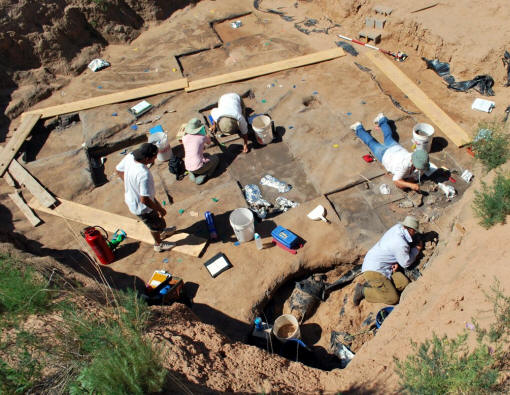
PHOTO CREDIT GEORGE CRAWFORD
CLICK ON PICTURE FOR LARGER IMAGE
EXCAVATION IN PROGRESS
BLACKWATER DRAW SITE
ROOSEVELT COUNTY, NEW MEXICO
This picture shows several
members of an archaeological team excavating on the Blackwater Draw
site. This recent excavation is located about 10 yards from the
Interpretive Center. They are excavating in stratum E where projectile
points, like Agate Basin and Scottsbluff, might be found and in stratum
D where earlier Folsom related artifacts might be found. |
|
|
Archaeologists have been Describing Blackwater Draw as one of the
most important early Paleo-Indian sites in North America for many years.
Wormington wrote in 1957, "One of the most important areas investigated
by students of Early Man is (Blackwater
Draw) a section between Clovis and
Portales in New Mexico which contains the remains of ancient lake beds."
and Lundelius wrote in 1972 "The early man site in Blackwater Draw near
Portales, New Mexico is one of the most interesting and important sites
in North America." The site was officially been recognized in 1961 as a
National Historic Landmark and was placed on the National
Register of Historic Places in 1966. |
|
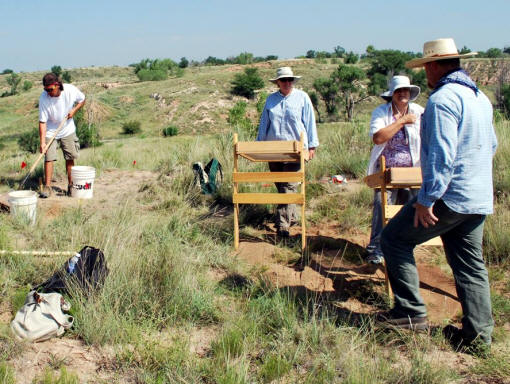
PHOTO CREDIT GEORGE CRAWFORD
CLICK ON PICTURE FOR LARGER IMAGE
EXCAVATION IN PROGRESS
BLACKWATER DRAW SITE
ROOSEVELT COUNTY, NEW MEXICO
This picture shows some
members of an archaeological team who are in the process of digging and
sifting on the Blackwater Draw site. This excavation site is located
approximately 100 yards south of the interpretive Center. This
excavation produced Archaic period and later more recent artifacts. |
|
|
The Blackwater Draw locality #1 site has had its share of
drama over the years. It's amazing that so many of the excavations seem
to have been just one
shovel away from the mining dredge. "Salvage archaeology" seems to have
been the battle cry as the quick digging technique evidently played a
major role. A very large number of people representing many different
institutions and amateurs, are to be commended for their efforts.
Although the destruction from mining was great, the information gained
from the site is without measure. |
|
"REFERENCES"
1944, Roberts, Frank H. H., "The New
World Paleo-Indian," Annual Report
of the Board of Regents of the Smithsonian Institution, p. 405.
1957, Wormington, H. M., "Ancient Man In North America" p. 47.
1972, Hester, James J., "Blackwater Locality No. 1", p. 4.
1972, Lundelius, Earnest L.,
"Vertebrate Remains From The Gray Sand," Blackwater Locality No.
1, A Stratified, Early Man Site In Eastern New Mexico, p. 148.
1999, Collins, Michael B. "Clovis Blade Technology, A Comparative
Study of the Keven Davis Cache, Texas," p. 150.
2005, Stanford, Dennis, "Paleoindian Archaeology And Late
Pleistocene Environments In The Plains And Southwestern United States,"
Ice Age Peoples Of North America, Environments, Origins, And
Adaptations, pp. 312 & 313.
2006, Huckell, Bruce B., and Judge, W. James, "Paleo-Indian: Plains and
Southwest,"
Handbook Of North American Indians, Environment, Origins, And
Population, Vol. 3, p. 152.
2012, Stanford, Dennis J., and Bradley, Bruce A., "Across Atlantic
Ice, The Origin Of America's Clovis Culture," p. 5.
Personal Communication, George Crawford
|
|
RECENT
LISTINGS HOME
ORDERING |
